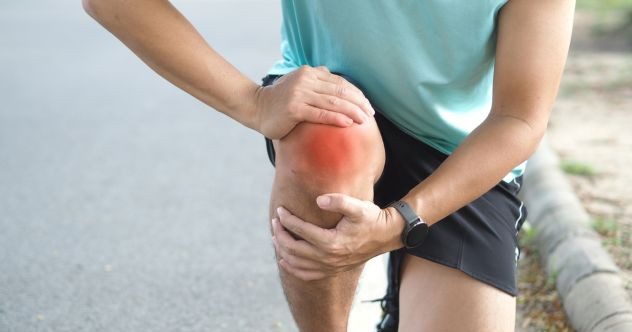Now Reading: 10 Science Fiction-Sounding New Medical Treatments
-
01
10 Science Fiction-Sounding New Medical Treatments
10 Science Fiction-Sounding New Medical Treatments

As medical technologies advance at exponential rates, they’re beginning to blur the already murky line between science fiction and science science. These are exciting exploratory steps toward a cyborg timeline, in which we boast modified muscles as well as inorganic livers, kidneys, and other organs that can withstand the rigors of a diet rich in cheeseburgers and soda, allowing us to indulge in multiple daily servings without consequence.
Whether they’re invented to heal acute injuries, ease chronic aches and pains, or tackle some of the world’s most debilitating diseases, the following advances prove that the future of medical creativity is now. Or soon, at least.
Related: Outbreak (1995): The Foreshadowing of 10 Modern Epidemics
10 A Pen Full of Pufferfish Poison to Ease Chronic Pain
TETRODOTOXIN PAIN TRIAL IN USA
Imagine a pen-or-marker-like device that could ease chronic pain. Devices shaped like that already exist, but now imagine that the pain-pacifying pen in question is filled with lethal pufferfish toxin because that’s exactly what scientists are exploring.
Just a few milligrams of that poison, tetrodotoxin, is enough to kill. But the newly innovated marker pen can distribute teeny-tiny doses to the skin, just enough to help with chronic pain. The toxin works by blocking a nerve’s ability to send electrical signals with insane potency: it’s 1,000 times stronger than conventional anesthetic and 3,000 times as potent as morphine.
A pen filled with tetrodotoxin could be better than other pain-neutralizing treatments, like opioids, because the pen specifically blocks pain transmission and presumably doesn’t cause constipation.
But would it be as likely to cause pufferfish-toxin-marker-pen addiction and abuse? Only the future will tell.[1]
9 Espresso-Science Can Inspire Better Treatments for Alzheimer’s Disease
Could espresso be key to fighting Alzheimer’s disease? | Morning in America
When people need to wake up fast and hard, they either opt for a radioactive-green energy drink or a dignified, delicious espresso. While the energy drink provides you with nine times your daily dose of taurine, coffee has multiple possible health benefits.
Including an interesting new one: in vitro lab tests suggest that “espresso compounds” halt the clumping of abnormal proteins associated with Alzheimer’s disease.
The protein in question is called tau, and when it’s healthy, it supports brain structure, like a scaffold. However, when these proteins become dysfunctional, they aggregate and clump together, a process associated with neurodegenerative diseases.
However, clumping was decreased when scientists exposed a form of the harmful tau protein to various coffee chemicals, including caffeine and theobromine, also found in chocolate.
Scientists aren’t saying that drinking your morning espresso will protect your brain from disease, but nearly half of all Americans already consume coffee on a daily basis. Most importantly, such studies inform the search for other bioactive compounds that can help prevent neurological decline.[2]
8 An Injectable Goo Fixes Sheep Knees, Could Someday Fix Yours
Chicago scientists develop revolutionary cartilage regeneration technology
Cartilage is tough, flexible, and essential for our joints and other notable features, like noses. It’s also incredibly important for daily comfort and performance, whether you’re a sports athlete or a desk athlete.
Regardless of career, when cartilage deteriorates, people feel it. And it can present a debilitating problem as bones begin to gnash against each other. Unfortunately, cartilage is hard to heal, both naturally and medically. Fortunately, scientists have created an injectable goo that shows promise in sheep knees (very similar to human knees).
The sheep-goo combines a bioactive peptide and a modified type of hyaluronic acid, which you can think of as mixing a scoop of collagen protein with a dab of wrinkle-reducing lotion. Because the first thing helps facilitate cartilage growth and maintenance, while the second thing is a common ingredient in your face cream and your joints.
As a result, this goo drives the formation of what’s described as high-quality cartilage to potentially fix creaking aching joints. Plus, it’s sheep-approved![3]
7 Tiny Self-Propelled Machines Swimming Around Your Insides to Kill Germs
Microbots Swim and Kill Bacteria
Microbes are humanity’s oldest friends (and foes). The human microbiome, our environment of germs, helps control many aspects of our lives, including our moods and the ultimate consequences of that late-night binge of shredded cheese. With the good comes the bad, as microbes are implicated in many sicknesses.
One novel way to kill germs is with “photoactive micromotors,” or little machines that move around the body when activated by light. The minuscule machines autonomously swim around in liquid, like that inside living organisms, when triggered by chemical reactions induced by light.
As they swim about, they release multiple substances, including silver, to attack bacteria. As they perform their function, the micromotors also self-destruct into harmless components, thereby avoiding the potential for harmful residues to remain in the body.
Accordingly, as researchers tested the micromotors against the common illness-causing bacteria E. coli and S. aureus, they were 99.999% efficient at destroying them. Should such technologies become truly viable, they could be a big boon to healthcare and perhaps change the future of micro-medicine.[4]
6 “Electric Tongue” Kills Harmful Mouth Germs
Your Mouth Is A Cave For Microbes
The microbiome in your mouth is also incredibly complex, with more than 700 types of microscopic critters calling it home. These include bacteria and fungi, some of which are harmful.
How can we identify the different types of microorganisms and ensure a beneficial balance? Possibly through a new innovation, an “electric tongue” that seeks and destroys the microscopic bad bugs. The “tongue” is a sensor array that uses nanoenzymes (like natural proteins made by the body) and analytics to detect and decode the very complex oral microbiome.
This “tongue” also has anti-bacterial properties to neutralize problematic microbes. An advance that could mean the death of dental diseases, infections, and bad breath? Yes, please![5]
5 Microscopic Flowers Heal Wounds
Nanobandage for Wound Healing
We’re lucky to exist in the era of incredible medical technologies, and the future promises to be even wilder, thanks to medical headlines like “wound-healing nanoflowers.”
Nanotechnology represents the next frontier in health, as per the just-mentioned nanoflower recently dreamed up by the American Chemical Society. It’s made of copper phosphate and tannic acid, which you may recognize as the acid associated with wine and leather-making.
Nanoflowers are self-forming and volumetrically tiny (i.e., nano), but they have lots of surface area for attaching drug molecules. When added to bandages and other dressings, the flowers offer multiple benefits: they’re antioxidant, they fight inflammation, and they neutralize bacteria in a natural, cost-effective way. As a bonus, they fared well when used to treat lab-grown human cells.[6]
4 Making Heart Muscle Patches to Treat Heart Failure
Beating heart patches could change the lives of heart failure sufferers- BBC London
Heart failure is associated with majorly detrimental health issues like high blood pressure, coronary artery disease, and heart attacks. Worse yet, heart failure affects more than 64 million people globally, and the medical treatments aren’t easy or cheap; heart transplants are in short supply, and implanting a heart pump can cause complications, in addition to being an intensive, expensive procedure.
Fortunately, scientists say they’ve made a breakthrough in the form of patches, which are made of beating cardiac muscle to help one’s natural heart pump blood throughout the body.
The patches are crafted from blood cells, which are “reprogrammed” to act like stem cells and then stimulated to become muscle and connective tissue cells.
These are combined with collagen and grown in a mold to create a muscular patch that’s implanted into the damaged portion of the heart. One 46-year-old woman has already received such a patch, made from donor cells, through a minimally invasive surgery. The results are promising, say medical researchers.[7]
3 Microbots to Heal Us from Within
Micro-Robots Deliver Drugs Directly to Tumors: Caltech Breakthrough | DRM News | AI1I
Today, our blood is full of microplastics. In the future, our blood could be full of robots. Only this would be a good thing because the robots’ job is to deliver targeted medication.
Also, maybe unexpectedly, these don’t look anything like the robots you’re picturing, most likely because they’re “tiny bubble-like spheres.” The reality is closer to fruition than ever, as a Caltech-led team has developed and trialed “microbots” with all the necessary features to be practical.
These microbots are controllable, resistant to bodily fluids like acid, capable of targeted drug delivery, and perfectly biocompatible as they absorb into the body once they’ve completed their mission.
Known as “bioresorbable acoustic microrobots” (BAM), they’re made of hydrogel through a process similar to 3D printing. Plus, they’re magnetic, allowing researchers to guide them using external magnetic fields.[8]
2 A Weight Loss Injection to Drink Less Alcohol
Ozempic and Wegovy may reduce alcohol cravings, some users say
Semaglutide is all the rage nowadays for helping people slim down, partially by decreasing appetite. In addition to helping people eat less, science says that semaglutide also reduces the craving for alcohol.
Almost a third of Americans have met alcoholic criteria at some point in their lives, and nearly 180,000 US deaths per year can be attributed to alcohol, which is linked to numerous diseases.
Fortunately, research has found that semaglutide reduces cravings; on average, it reduces consumption by 30% on drinking days. It almost slashed heavy drinking days (four or more drinks for women, five or more for men) by a significant amount: nearly 40% of people reported ZERO heavy drinking days during their second month of treatment.
Importantly, these effects are generally greater than seen with drugs designed to smother alcohol cravings, even with semaglutide administrations at their lowest dose. As a bonus, nicotine addiction was also reduced.[9]
1 Turning Plants into “Bio-Factories” to Crank Out Supplements
Biopharming: Turning Plants into Medicine Factories (2 Minutes)
As if plants weren’t already lovable enough—making oxygen and vitamins for us while looking pretty—here’s another reason to love our leafy friends: scientists are turning them into “bio-factories” capable of producing supplements that usually come from animals.
It’s simple in theory, and the plants are down with the idea, apparently, as they’re “surprisingly receptive” when tasked with making new substances. Researchers accomplished this by transferring DNA instructions into the plants via a bacterium.
These instructions may include recipes for compounds such as creatine, carnosine, and taurine, as well as other proteins. By packaging the instructions as “synthetic modules,” the researchers were able to get a tobacco-like plant (Nicotiana benthamiana) to make some animal-derived substances—but not much taurine, at least not yet. If potentially perfected, we can all expect a novel source of extra taurine in our favorite energy drinks.[10]
fact checked by
Darci Heikkinen























